|
Featured Article: Roosevelt's Recession: A Historical and Econometric Examination of the Roots of the 1937 Recession
In July 1933, journalist Walter Lippman concluded a radio interview with Keynes by stating, “It may be that at the present state of human knowledge we are not equipped to understand a crisis which is so great and so novel.” A scramble for new knowledge and new theories defined the state of economic thought during the early Depression years. Yet, these new theories did not always translate into government policy.
The architects of the New Deal were lawyers, public servants, and business leaders, not economists and mathematicians. To combat the Depression, they relied more on theories rooted in philosophy than theories rooted in mathematics. For them, the Depression was to be blamed on income inequality, monopolies, and wasteful inefficiencies in production. It was as if politicians and economists spoke different languages. For example, President Roosevelt, after his first personal meeting with Keynes, said that he “liked [Keynes] immensely,” but the President nonetheless complained that Keynes talked like a “mathematician.”
A clear divide existed between political leaders, struggling to enact effective policies, and economists, struggling to advocate for and explain new theories. In addition to a divide rooted in communication of theory, policymakers and economists were divided in their goals by political strategy. The Depression years were a politically favorable time to pass long-term welfare reform efforts; such reforms were passed alongside immediate economic recovery efforts. In regards to this mixing of policies, Keynes warned the President against combining long-run welfare reform with short-term recovery efforts.
Many of the early New Deal programs enacted by the Roosevelt administration were policies rooted in a desire for relief, not recovery. When these programs were created, the multiplier effect theory had not yet been firmly established. The principle of the multiplier effect, in an oversimplified sense, is that a unit increase in spending would impact the economy at a rate greater than one unit. Richard Kahn, a student of Keynes, first proposed the theory in 1931. However, it took Keynes three years to relate the theory to spending; it wasn’t until 1934 that the theory gained prominence and was brought to the forefront of political discourse.
In 1933, the Brains’ Trust drafted programs aimed at relief. What they didn’t know at the time was that these programs aided recovery; employing the needy, hungry, and jobless did not only aid those directly employed, it also stimulated the economy as a whole. Keynes was so instrumental in the development of deficit-spending theories during the Depression that today a page about the New Deal on the FDR Library website is titled “FDR: From Budget Balancer to Keynesian.” However, based on the events of 1936 and 1937, a more honest title would be “FDR: From Budget Balancer to Keynesian to Budget Balancer. The Fight for the Soldier’s Bonus.”
Between 1935 and 1937, the economy expanded at a pace that surprised many. Unfortunately, the expansion was not spurred by the private sector, but by government spending decisions. Whatever policy choices led to the Recession, whether monetary or fiscal, the choices were influenced by a belief that expansionary policy was no longer required given the rapid expansion of the economy. For example, in March 1936, commercials loans began rising for the first time since 1929. However, as the year progressed, the volume of loans increased not due to improved economic conditions, but mainly due to the Soldier’s Bonus payment of 1936.
The Soldier’s Bonus payment was the result of a prolonged lobbying effort by veterans’ groups that began as early as 1919. President Harding vetoed the first iteration of the bonus bill that successfully passed both chambers of Congress on September 19, 1922. In response, the House voted to override the veto 258 to 54, but the override failed in the Senate by only four votes. Given its widespread popularity, clearly underscored by the overwhelming support it received in Congress, the bill soon reappeared on the legislative docket.
Two years later, President Coolidge vetoed a similar bonus bill on May 15, 1924. Both chambers overrode Coolidge’s veto, and the Act became law on May 19, 1924. The Act established a fund that granted varying levels of monetary compensation to veterans for their service during World War I. The Act took the form of an old-age pension system because it stipulated that the benefit could be redeemed beginning only in the year 1945. Although unpopular with veterans’ groups, the prolonged maturity window provided the bi-partisan support that was needed to override Coolidge’s expected veto.
As the Great Depression swept the nation during Hoover’s Presidency, veterans’ groups lobbied extensively for an early disbursement of the bonus. In 1932, thousands of jobless veterans, called the Bonus Army, gathered at a Washington D.C. campsite to rally for early payment.
On June 17, the Senate defeated an early disbursement bill that was passed in the House of Representatives. Undeterred, the Bonus Army continued camping in Washington in the hopes of successfully pressuring President Hoover. As weeks passed, the Hoover Administration became less welcoming of the protestors. In an attempt to end the protest, the Attorney General ordered police to clear the campsite on July 28, 1932. The ill-fated decision ultimately led to the Bonus Army Riots, an event that proved to be politically disastrous for Hoover as photographs of veterans under attack spread across the nation.
When President Roosevelt assumed office only a few months later, he quickly moved to end the protests. FDR offered jobless veterans employment through his new program: the Civilian Conservation Corps. Although the protestors were now out of the way, veterans’ groups continued to lobby for early disbursement of the bonus. Their lobbying efforts were unsuccessful in securing enough votes to override a veto, but that changed after the 1935 Labor Day Hurricane reframed political discourse. The hurricane led to a public relations disaster that, in part, contributed to an early disbursement of the soldier’s bonus.
The category five hurricane made landfall in Florida and killed hundreds of veterans employed in regional work camps. The hurricane’s impact made national news; front-page headlines appeared multiple days in a row, even in national newspapers like the New York Times. On September 3, 1935, the Times reported on a train dispatched to evacuate seven hundred veterans from a federal bridge project. The next day, Times’ readers were confronted with grim front-page articles. The headlines read “75 Veterans Reported Dead in Storm” and “Veterans’ Camp Wrecked By Storm.” By September 5, the extent of the devastation became clear. On that day, a front-page headline noted “Veterans Lead Fatalities: Only 11 of 192 Reported as Left Alive in One Florida Camp.”
The Veterans of Foreign Wars, a group that advocated for early disbursement, used the high veteran death toll as a springboard to criticize FDR. On September 14, the group’s national commander, James E. Van Zandt, accused the government of having sent the veterans to Florida in the interest of forestalling bonus army demonstrations. Although it lacked any palatable accusation of negligent behavior, the Commander’s meaningless accusation about job-placement intent proved to be politically toxic. Whether the result of dismay over the death toll a politically-calculated media campaign, supporters of early disbursement transformed an otherwise innocent accusation of intent into a headline-grabbing accusation of negligence through the dubious use of casual reasoning fallacies. Washington, and more specifically, the President, was portrayed as putting political interests above the safety of veterans.
To put in perspective the critical social climate among more moderate critics, one can examine the rhetoric and criticism deemed acceptable for publication at the outskirts of the political spectrum. For this purpose, an article written by Ernest Hemingway for "The New Masses” is exemplary. "The New Masses" was a leftist magazine with Marxist roots that experienced a surge in circulation during the Depression. The magazine is known for accepting for publication but not printing, Abel Metropol’s "Strange Fruit,” a poem later made legendary by Billie Holiday. Although not a mainstream magazine, neither was it a fringe-interest publication.
Hemingway’s piece appeared in print on September 17, 1935. The scathing article was provocatively titled “Who murdered the vets?” In addition to the title, Hemingway’s clear bias yet politically-damaging criticism is best highlighted by the three questions he asks at the start of his piece: “Whom did they [bonus marchers] annoy and to whom was their possible presence a political danger? Who sent them down to the Florida Keys and left them there in hurricane months? Who is responsible for their deaths?” Throughout his piece, Hemingway chose words that suggested only one individual was ultimately responsible for the hurricane deaths. That individual, of course, was Roosevelt, a President who just months earlier vetoed an early-disbursement bill.
In the end, it was not a bruised Roosevelt that gave in to demands for a bonus. Congress, perhaps more attuned and vulnerable to shifts in public sentiment during an election year, presented a new early-disbursement bill to Roosevelt on January 22, 1936. The President vetoed the bill, but he was overridden, and the bill became law on January 27, 1936.
After his veto was overridden, three national commanders of three veterans organizations spoke with FDR at the White House. They tried to qualm the President's concerns about inflation resulting from a surge in currency starting in June 1936, the starting month for cash withdrawal. The Commanders informed the President that they would urge their members to retain the bonds and not cash them until 1945. By August 1936, 71% of the $1.7 Billion total bonus was converted into cash. The influx of cash into the economy likely contributed to an inflated sense of security because the Soldier’s Bonus had a rapid, positive impact on economic conditions.
As early as 1936, some within the administration believed the Great Depression was over. President Roosevelt underscored this assumption in his annual message to Congress on January 6, 1937. In his address, FDR asked Congress to continue enacting progressive policies in the interest of American society, even though the depression was over. He stated, “Your task and mine is not ending with the end of the depression.” The following day, January 7, the President presented Congress with the proposed budget for 1938. Multiple times in the proposal, the President highlighted that the budget was balanced and that there was a lessened need for work relief expenditures. He informed Congress that economic "gains make it possible to reduce for the fiscal year 1938 many expenditures of the Federal Government which the general depression made necessary. Although we must continue to spend substantial sums to provide work for those whom industry has not yet absorbed, the 1938 Budget is in balance.”
During the first half of 1937, economic conditions appeared to be favorable, and there were few signs of a looming downturn. An extensive archival search of presidential press conference minutes yielded nearly no inquiries of concern over economic conditions. Through June of 1937, the only question raised by the press about troublesome economic indicators took place at a press conference on April 2, 1937. In response to a journalist’s question, the President said, “Everybody who has been reviewing the existing economic situation is pretty well agreed that the present increase in the production of durable goods is going more rapidly than the production of consumer goods and that… does constitute a danger sign.” At the press conference, FDR suggested that ending public works projects, like bridge and dam building, would aid durable good price stabilization because the projects required a wide variety of durable goods ranging from steel to concrete. Other than the April 2 remarks, FDR expressed little concern about the economy during his press conferences until the onset of the Recession in the late summer months.
The index of industrial production, plotted in Figure 2, shows a modest decline in output between August and September 1937, a drastic collapse in output between September and December, and a tapering off between December 1937 and May 1938. In the list below, the industrial production index is provided for every month of output decline during the Recession. The monthly index values are provided as a percent of output in August 1937. The figures within parenthesis are percent changes from the previous month.

The start of the Recession took the nation by surprise. Unlike the Stock Market Crash of 1929 and the events that followed, the Recession was not heralded into public discourse by any set of singularly significant and alarming events. Confusion plagued the nation as economic indicators during the early weeks of the Recession trickled in evidence that was worrisome but inconclusive.
The earliest and most public sign of trouble occurred on October 18, 1937, when the stock market experienced “a spectacular decline.” By the end of the day, stock values of some of the largest corporations in the country declined to less than half of their 1937 peaks. In the ten months leading to October, Chrysler stock reached a high of $135.25 and closed on October 18 at $62.25; GM reached a 1937 high of $70.5 and slumped to $36; Warner Pictures reached a high of $18 and closed at $6; U.S. Steel reached a 1937 high of $126.5 and closed on October 18 at $61.5.
Although the October 18 slump was soon followed "by an equally spectacular recovery” on October 20, fear permeated the country during that 48-hour period. Between October 18 and the early morning hours of October 19, the White House received over forty telegrams urging FDR to close the stock market. In an early afternoon phone call with Morgenthau on October 19, FDR plainly summarized the prevailing sentiment when he noted, “The White House has the jitters.” With 1929 seared in collective consciousness, all eyes across the country were focused on stock market conditions. Twice on the morning of the 19th, at 10:16 a.m. and 10:56 a.m., Morgenthau telephoned W. Randolph Burgess, then the Vice-President of the Federal Reserve Bank of New York, to check on market conditions. During the first call, Burgess told Morgenthau, “Things have been fairly quiet so far.” Later that afternoon, at 1:15 p.m., FDR called Morgenthau to inquire about the market situation. Morgenthau informed the President that conditions were satisfactory but not improving; the two discussed little else during their short call.
The next day, October 20, Morgenthau telephoned FDR, and in a serious voice said, “I am terribly worried. I think you had better close the stock markets.” When the President asked why, Morgenthau laughingly replied, “It’s going up too fast!” The markets were surging, but the good news proved to be temporary. Only two weeks later, on the evening of November 3, Morgenthau wrote the first draft of a letter to be sent to the President. The letter read, in part, “I have had to come to the conclusion that we are headed right into another depression.” The warning in Morgenthau’s letter stood in contrast to statements that were made just weeks and months earlier. Economic conditions unexpectedly turned negative. Earlier in 1937, even the President was confident that the economy had recovered. Having assumed recovery, FDR asked Congress, on April 20, to curtail work relief spending. He confidently stated, "While I recognize many opportunities to improve social and economic conditions through Federal action, I am convinced that the success of our whole program and the permanent security of our people demand that we adjust all expenditures within the limits of my Budget estimate.”
The atypical nature of the 1937 downturn was matched in its peculiarity only by the atypical response Roosevelt took to addressing economic conditions. A search of press conference questions concerning business and economic conditions, as indexed by the FDR Library for the months between September 1937 and January 1938, reveals that the President systematically refused to answer questions regarding the slump. In contrast to his earlier years in office, FDR stood silent as the Recession began.
One of the earliest questions about the Recession was asked at press conference on October 8, 1937. During the conference, a reporter asked the President, “Will you comment on the business situation?” The President replied, “No.” Two weeks later, on October 22, the President again was asked about the Recession, “Are you getting any reports… on which you could base a business outlook statement for the Winter of the next Spring? There is a lot of talk about a let-down or recession.” FDR informed the reporter that no special reports exist. Although he replied to the direct question about special reports, it’s important to highlight that FDR’s reply did not address the reporter’s statement about a possible recession.
Even though he was being questioned about a downturn, the President, firm in his desire for a balanced budget, announced on October 19 that “the estimated expenditures under the recovery and relief program will be $1,139,000,000 less than in 1937."
In November and early December, the President continued to dodge specific questions about economic conditions. However, while he declined to comment, the President at very least acknowledged that conditions were subpar. By the end of the year, it was clear that the economy was in recession. The President finally began addressing, in more detail, recession-related questions; his replies were longer, more detailed and comprehensive than those from earlier months.
While the President seemed to be in a prolonged state of denial of recession in public messages, the American public was highly attuned to minute changes in economic conditions. The public followed news of economic conditions closely due to the experiences of and hardships felt during the earlier Depression years. In addition to newspapers of record like The New York Times and The Wall Street Journal, economic conditions were reported on at a surprising frequency, even in smaller, regional newspapers that catered to middle and working class Americans.
Across the country, from New Orleans' Times Picayune, to Brownsville, Texas’ Brownsville Herald, to Brooklyn’s Daily Eagle, the state of the economy was a key news topic. Soon after the President’s 1937 address to congress, the Times Picayune published an article announcing “1937 will be our first year of real prosperity since 1929” but only if labor leaders refrain from creating industrial conflict. Three days later, a positive news article highlighted the improved economic conditions in key segments of the economy. On April 2, 1937, The Brownsville Herald discussed at length the possible impact of new taxes, budget balancing, and higher wages. In the same week, The Brownsville Herald published other articles that concerned, at length, present economic conditions. Clearly, economic conditions were at the forefront of both hyper-local and national news. The President’s silence about conditions during late 1937 should be considered highly unusual given the country’s vast interest in the state of the economy.
Yet, while there where indications of trouble with the economy by early Fall 1937, the government was sending mixed messages. On one hand, Washington was beginning to address worsening conditions, while on the other hand, the government was strongly advocating for a balanced budget because widespread relief programs were no longer necessary. In its announcements, the administration lost the consistency that had previously defined public announcements about the economy and future outlook.
Morgenthau spent hours over a three-month time-span preparing for a significant policy-related speech to be delivered before the Academy of Political Science on November 10, 1937. So much attention was paid to this speech that the number of speech-related records, including meeting and call transcripts, drafts and revisions, research data, and memos, had to be split into three volumes for record-keeping. The three volumes consist of nearly 900 pages. The close scrutiny paid to drafting this speech underscores the long-standing preoccupation with a balanced budget that came to the forefront of political discourse over the past year. While the Recession took off, focus was on the budget, not on economic conditions.
In regards to Morgenthau’s speech, planning for the speech began on September 13. By October 28, it was decided that the speech would consist of three parts: “reasons why the budget should be balanced,” “how the budget can be balanced,” and “considerations involving the debt retirement question.” After over fifteen drafts, the final speech was delivered at the Astor Hotel on Wednesday, November 10.
Although he was Roosevelt’s Treasury Secretary during a time when the federal deficit expanded, Morgenthau strongly believed that the key to expansion was a balanced budget and private industry. This was a view he recurrently advocated for. His speech before the Academy was one of the most public, and most targeted, policy declarations that Morgenthau addressed during his time in the administration.
In the speech, he praised the President for his emergency expenditures, but he strongly argued that spending was no longer needed. He noted “this (economic) war… required a many-sided campaign under intelligent and courageous leadership.” However, Morgenthau plainly announced, “The emergency that we faced in 1933 no longer exists.” He contends that others believe “that another great spending program is desirable to ward off the risk of another business depression,” but Morgenthau asserted that "the domestic problems which us today are essentially different from those which faced us four years ago.” The long speech continues to highlight the benefits of a balanced budget and a cutting back of fiscal policy. Unfortunately, Morgenthau’s speech and his predictions were untimely. Even though economic indicators hinted at recession, his speech was packed with statements that should have been made less confidently. At the start of the Recession, the Treasury Secretary proudly announced, “We are nearing the end of one of the most active years in the business history of this country.”
Five days before Morgenthau’s optimistic speech, the President addressed Congress in a radically different tone. He begins the address by informing Congress, since their last adjournment in August, "There has been a marked recession in industrial production and industrial purchases.” However, keeping in line with the views favored by Morgenthau, the President did not call on Congress for public expenditures. He told Congress that following: "The continuance of business recovery in the United States depends far more upon business policies than it does upon anything that may be done, or not done, in Washington.” The President requested legislation to protect labor and keep wages from declining. In his view, labor issues in industry and agriculture, not fiscal and monetary policies, caused the Recession.
Keynes, who had withdrawn from public life since a serious heart attack in the summer of 1937, wrote to the President on February 1, 1938. In the eight-page letter, Keynes’ outlined his views about the causes of the Recession. Keynes praised the President for his earlier spending programs that were the roots of recovery. In regards to the Recession, Keynes pointed to the curtailment of these programs as the cause. He plainly informs the President that, unless the decline in government spending was supplemented by an expansion in spending in other parts of the economy, “the present slump could have been predicted with absolute certainty.” Keynes agreed that the Recession was caused by an “error of optimism.” Unlike the President and other members of the administration, Keynes did not consider this an error of overproduction in the private sector, but an error of spending decline on the government’s part. Keynes ended the letter with a warning: “The maintenance of prosperity in the modern world is extremely difficult…it is so easy to lose precious time.”Continued on Next Page »
An Act to Diminish the Causes of Labor Disputes Burdening or Obstructing Interstate and Foreign Commerce, to Create a National Labor Relations Board, and for Other Purposes., Pub. L. No. 74-198, Stat. (July 5, 1935). Accessed January 16, 2015. http://research.archives.gov/description/299843.
An act to provide adjusted compensation for veterans of the World War, and for other purposes., H.R. 10874, 67th Cong., 2d Sess. (1922).
Adjusted Compensation Payment Act, ch. 32, 49 Stat. 1099-1102 (Jan. 27, 1936).
Allen, William R. "Irving Fisher, F. D. R., and the Great Depression." History of Political Economy 9, no. 4 (1977): 560-87. http://EconPapers.repec.org/RePEc:hop:hopeec:v:9:y:1977:i:4:p:560-587.
Baker, Nancy. "Abel Meeropol (a.k.a. Lewis Allan): Political Commentator and Social Conscience." American Music 20, no. 1 (Spring 2002): 25-79.
Barber, William J. From New Era to New Deal: Herbert Hoover, the Economists, and American Economic Policy, 1921-1933. Cambridge: Cambridge University Press, 1988.
Black, Conrad. Franklin Delano Roosevelt: Champion of Freedom. New York: Public Affairs, 2003.
Board of Governors of the Federal Reserve System (US), Industrial Production Index[INDPRO], retrieved from FRED, Federal Reserve Bank of St. Louis https://research.stlouisfed.org/fred2/series/INDPRO/, April 4, 2015.
Brown, E. Cary. "Fiscal Policy in the 'Thirties: A Reappraisal." The American Economic Review 46, no. 5 (December 1956): 857-79.
The Brownsville Herald (Brownsville, TX). "Prices." April 2, 1937, 1.
The Brownsville Herald (Brownsville, TX). "Public Funds Will Control High Prices?" April 4, 1937, 1-2.
Burns, Arthur F., and Wesley C. Mitchell. Measuring Business Cycles. Studies in Business Cycles 2. New York: National Bureau of Economic Research, 1946.
Cargill, Thomas F., and Thomas Mayer. "The Effect of Changes in Reserve Requirements during the 1930s: The Evidence from Nonmember Banks." The Journal of Economic History 66, no. 2 (June 2006): 417-32.
Cole, Harold L., and Lee E. Ohanian. "New Deal Policies and the Persistence of the Great Depression: A General Equilibrium Analysis." Journal of Political Economy 112, no. 4 (August 2004): 779-816. Accessed January 16, 2015. doi:10.1086/421169.
Complete Set of Speech Drafts. Volume 97: November 10, 1937. Diaries of Henry Morgenthau, Jr. Franklin D. Roosevelt Presidential Library & Museum, Hyde Park, NY.
Conference to Talk Over Plans, 9/13/37. Volume 95: November 10, 1937; Page 1. Diaries of Henry Morgenthau, Jr. Franklin D. Roosevelt Presidential Library & Museum, Hyde Park, NY.
"Document 50: February 28, 1938, Letter with Attachments, To: Keynes From: Roosevelt." In FDR's Response to Recession, edited by George McJimsey, 303-12. Vol. 26 of Documentary History of the Franklin D. Roosevelt Presidency. N.p.: University Publications of America, 2005.
Draft Letter to FDR. November 3, 1937. Volume 94: November 1-November 10, 1937; Page 47. The Diaries of Henry Morgenthau, Jr. Franklin D. Roosevelt Presidential Library & Museum, Hyde Park, NY.
Dutcher, Rodney. "Behind the Scenes in Washington." The Brownsville Herald (Brownsville, TX), April 2, 1937, 4.
Edsforth, Ronald. The New Deal: America's Response to the Great Depression. Malden, MA: Blackwell Publishers, 2000.
Eggertsson, Gauti B. Great Expectations and the End of the Depression. Staff Report no. 234. N.p.: Federal Reserve Bank of New York, 2005.
———. "Great Expectations and the End of the Depression." American Economic Review 98, no. 4 (September 2008): 1476-516. doi:10.1257/aer.98.4.1476.
Eggertsson, Gauti B., and Benjamin Pugsley. "The Mistake of 1937: A General Equilibrium Analysis." Monetary and Economic Studies 24, nos. S-1 (December 2006): 151-90.
Eichengreen, Barry. "The U.S. Capital Market and Foreign Lending, 1920–1955." In Developing Country Debt and Economic Performance: The International Financial System, by Susan Margaret Collins and Jeffrey Sachs, 107-56. Vol. 1. Chicago: University of Chicago Press, 1989. Previously published as "Til Debt Do Us Part: The U.S. Capital Market and Foreign Lending, 1920-1955." NBER Working Paper W2394. http://www.nber.org/chapters/c8988.
"FDR: From Budget Balancer to Keynesian, A President's Evolving Approach to Fiscal Policy in Times of Crisis." Franklin D. Roosevelt Presidential Library and Museum. http://www.fdrlibrary.marist.edu/aboutfdr/budget.html.
Federal Reserve Board. Tenth Annual Report of the Federal Reserve Board: Covering Operations for the Year 1923. Washington: Government Printing Office, 1924. Accessed November 23, 2014. https://fraser.stlouisfed.org/docs/publications/arfr/1920s/arfr_1923.pdf.
Fisher, Irving. Booms and Depressions: Some First Principles. New York: Adelphi, 1932.
———. "The Debt-Deflation Theory of Great Depressions." Econometrica 1, no. 4 (October 1933): 337-57. DOI:10.2307/1907327.
———. "Dollar Stabilization." In Encyclopedia Britannica, 852-53. Vol. XXX. http://www.econlib.org/library/Essays/fshEnc1.html.
———. "Mathematical Investigations in the Theory of Value and Prices." Transactions of the Connecticut Academy of Arts and Sciences 9 (1892): 1-124.
———. "Our Unstable Dollar and the So-Called Business Cycle." Journal of the American Statistical Association 20, no. 150 (June 1925): 179-202. doi:10.2307/2277113.
———. "Stabilizing Price Levels." The New York Times, September 2, 1923, sec. XX, 10.
———. "Why Has the Doctrine of Laissez Faire Been Abandoned?" Science, n.s., 25, no. 627 (January 4, 1907): 18-27. http://www.jstor.org/stable/1633692.
Friedman, Milton, Paul A. Samuelson, and Henry Wallich. "How the Slump Looks to Three Experts." Newsweek, May 25, 1970, 78-79. Accessed November 23, 2014. http://hoohila.stanford.edu/friedman/newsweek.php.
Friedman, Milton, and Anna Jacobson Schwartz. A Monetary History of the United States 1867-1960. 9th ed. Princeton: Princeton University Press, 1993.
Gordon, Robert J., and Robert Krenn. "New Gordon-Krenn quarterly and monthly data set for 1913-54." Unpublished raw data, Northwestern University, n.d. Accessed March 30, 2015. http://faculty-web.at.northwestern.edu/economics/Gordon/researchhome.html.
Hearings Before the Banking, Housing, and Urban Affairs (2009) (statement of Lee E. Ohanian). Accessed January 25, 2015. http://www.banking.senate.gov/public/index.cfm?FuseAction=Files.View&FileStore_id=6cce4fbb-e7cd-4699-8892-9c5d1285e871.
Hemingway, Ernest. "Who Murdered the Vets?" The New Masses, September 17, 1935, 9-10. Accessed March 10, 2015. http://www.unz.org/Pub/NewMasses-1935sep17-00009.
Hobsbawm, E. J. Industry and Empire: The Birth of the Industrial Revolution. Edited by Chris Wrigley. New York: New Press, 1999. Originally published as Industry and Empire: An Economic History of Britain Since 1750 (London: Weidenfeld & Nicolson, 1968).
Jones & Laughlin Steel Corp. v. NLRB, 301 U.S. (1937). Accessed January 16, 2015. https://supreme.justia.com/cases/federal/us/301/1/case.html.
Kahn, Richard. "The Relation of Home Investment to Unemployment." The Economic Journal 41, no. 162 (June 1931): 173-98.
Keynes, John Maynard. "Chapter 24: Concluding Notes on the Social Philosophy towards Which the General Theory Might Lead." In The General Theory of Employment, Interest, and Money.
———. "The Great Slump of 1930." The Nation and Athenaeum 48 (December 20, 1930): 402.
———. "The Great Slump of 1930 II." The Nation and Athenaeum 48 (December 27, 1930): 427-28.
———. A Tract on Monetary Reform. 1923. Reprint, London: Macmillan, 1924.
Kindleberger, Charles Poor. The World in Depression, 1929-1939. Berkeley: University of California Press, 1973.
May, Dean L. From New Deal to New Economics: The Liberal Response to the Recession. Edited by Frank Freidel. Modern American History. New York: Garland Publishing, 1981.
Mehrotra, Ajay K. "Edwin R.A. Seligman and the Beginnings of the U.S. Income Tax." Tax Notes, November 14, 2005, 933-50.
Nasar, Sylvia. Grand Pursuit: The Story of Economic Genius. New York: Simon & Schuster, 2011.
NBER. The End of the Great Depression 1939-41: Policy Contributions and Fiscal Multipliers. By Robert J. Gordon and Robert Krenn. Working Paper no. 16380. 2010. Accessed March 30, 2015. doi:10.3386/w16380.
The New York Times. "Bonus Bill Becomes Law." January 28, 1936, Late City edition, 1. Accessed March 8, 2015. http://timesmachine.nytimes.com/timesmachine/1936/01/28/87903226.html?pageNumber=1.
The New York Times. "Both Coasts Threatened." September 3, 1935, Late City edition, 1. Accessed March 8, 2015. http://timesmachine.nytimes.com/timesmachine/1935/09/03/issue.html.
The New York Times. "Fisher Sees Stocks Permanently High." October 16, 1929, 8.
The New York Times. "Link Bonus Issue to Florida Deaths." September 15, 1935, Late City edition, N6. Accessed March 8, 2015. http://timesmachine.nytimes.com/timesmachine/1935/09/15/93707816.html?pageNumber=99.
The New York Times. "The Stock Market." October 20, 1937, Late City edition, 22. Accessed March 8, 2015. http://timesmachine.nytimes.com/timesmachine/1937/10/20/103216107.html?pageNumber=22.
The New York Times. "Veteran's Camp Wrecked by Storm." September 4, 1935, Late City edition, 1. Accessed March 8, 2015. http://timesmachine.nytimes.com/timesmachine/1935/09/04/93481928.html.
The New York Times. "Veterans Lead Fatalities. Only 11 of 192 Reported as Left Alive in One Florida Camp." September 5, 1935, Late City edition, 1. Accessed March 8, 2015. http://timesmachine.nytimes.com/timesmachine/1935/09/05/93482496.html?pageNumber=1.
Office of the Secretary of the Senate, Presidential Vetoes, 1789-1988, S. Doc. No. 102-12 (1992). Accessed March 8, 2015. http://www.senate.gov/reference/resources/pdf/presvetoes17891988.pdf.
"131 'I Pledge You—I Pledge Myself to a New Deal for the American People.' the Governor Accepts the Nomination for the Presidency, Chicago, Ill. July 2, 1932." In The Genesis of the New Deal, 1928-1932, 647-58. Vol. 1 of The Public Papers and Addresses of Franklin D. Roosevelt. New York: Random House, 1938.
Papadimitriou, Dimitri B., and Greg Hannsgen. Lessons from the New Deal: Did the New Deal Prolong or Worsen the Great Depression? Working Paper no. 581. Annandale-on-Hudson, NY: Levy Economics Institute of Bard College, 2009.
Personal Memo. October 19, 1937. Volume 92: October 12-October 19, 1937; Page 229. The Diaries of Henry Morgenthau, Jr. Franklin D. Roosevelt Presidential Library & Museum, Hyde Park, NY.
"Press Conference #425-15." January 14, 1938. Press Conferences of President Franklin D. Roosevelt, 1933-1945. Franklin D. Roosevelt Presidential Library & Museum, Hyde Park, NY.
"Press Conference #434." February 15, 1938. Press Conferences of President Franklin D. Roosevelt, 1933-1945. Franklin D. Roosevelt Presidential Library & Museum.
Press Conference #401-1. October 8, 1937. Press Conferences of President Franklin D. Roosevelt, 1933-1945. Franklin D. Roosevelt Presidential Library & Museum, Hyde Park, NY.
"Press Conference #405-5." October 22, 1937. Press Conferences of President Franklin D. Roosevelt, 1933-1945. Franklin D. Roosevelt Presidential Library & Museum, Hyde Park, NY.
"Press Conference #409-7." November 9, 1937. Press Conferences of President Franklin D. Roosevelt, 1933-1945. Franklin D. Roosevelt Presidential Library & Museum, Hyde Park, NY.
"Press Conference #415-8." December 10, 1937. Press Conferences of President Franklin D. Roosevelt, 1933-1945. Franklin D. Roosevelt Presidential Library & Museum, Hyde Park, NY.
"Press Conference #416-4." December 14, 1937. Press Conferences of President Franklin D. Roosevelt, 1933-1945. Franklin D. Roosevelt Presidential Library & Museum, Hyde Park, NY.
"Press Conference #357." April 2, 1937. Page 239. Press Conferences of President Franklin D. Roosevelt, 1933-1945. Franklin D. Roosevelt Presidential Library & Museum.
Romer, Christina D. "Lessons from the Great Depression for Economic Recovery in 2009." Speech presented at Brookings Institution, Washington D.C., March 9, 2009. Accessed April 21, 2015. http://www.brookings.edu/~/media/events/2009/3/09-lessons/0309_lessons_romer.pdf.
———. "Spurious Volatility in Historical Unemployment Data." Journal of Political Economy 94, no. 1 (February 1986): 1-37. http://www.jstor.org/stable/1831958.
———. "What Ended the Great Depression?" The Journal of Economic History 52, no. 4 (December 1992): 757-84.
Roose, Kenneth D. The Economics of Recession and Revival: An Interpretation of 1937-38. Yale Studies in Economics 2. New Haven: Yale University Press, 1954.
———. "The Recession of 1937-38." Journal of Political Economy 56, no. 3 (June 1948): 239-48. Accessed January 26, 2015. http://www.jstor.org/stable/1825772.
———. "The Role of Net Government Contribution to Income in the Recession and Revival of 1937-38." The Journal of Finance 6, no. 1 (March 1951): 1-18. DOI:10.1111/j.1540-6261.1951.tb04437.x.
Roosevelt, Franklin D. "Annual Budget Message to Congress." Address, January 7, 1937. The American Presidency Project. http://www.presidency.ucsb.edu/ws/?pid=15337.
———. "Annual Message to Congress." Address, January 6, 1937. The American Presidency Project. http://www.presidency.ucsb.edu/ws/?pid=15336.
———. "Fireside Chat on Banking." Speech, March 12, 1933. The American Presidency Project. http://www.presidency.ucsb.edu/ws/?pid=14540.
———. "Message to Congress Recommending Legislation, November 5, 1937." The American Presidency Project. http://www.presidency.ucsb.edu/ws/?pid=15496.
———. "Proclamation 2040 - Bank Holiday." The American Presidency Project. http://www.presidency.ucsb.edu/ws/?pid=14485.
———. "Proclamation 2039 - Declaring Bank Holiday." The American Presidency Project. http://www.presidency.ucsb.edu/ws/?pid=14661.
———. "60 - Message to Congress on Appropriations for Work Relief for 1938. April 20, 1937." The American Presidency Project. Accessed March 19, 2015. http://www.presidency.ucsb.edu/ws/?pid=15393.
———. "Statement Summarizing the 1938 Budget, October 19, 1937." The American Presidency Project. Accessed March 22, 2015. http://www.presidency.ucsb.edu/ws/?pid=15486.
Schumpeter, Joseph A. "Chapter 5.4: Unemployment and the ‘State of the Poor’." In History of Economic Analysis, 258-63. Edited by Elizabeth B. Schumpeter. New York: Oxford University Press, 1954.
Shlaes, Amity. The Forgotten Man: A New History of the Great Depression. New York: Harper Collins, 2007.
Smith, Adam. An Inquiry into the Nature and Causes of the Wealth of Nations. Edited by Edwin Cannan. 5th ed. 1776. Reprint, London: Methuen & Co., 1904. http://www.econlib.org/library/Smith/smWN.html.
Telser, Lester G. "Higher Member Bank Reserve Ratios in 1936 and 1937 Did Not Cause the Relapse into Depression." Journal of Post Keynesian Economics 24, no. 2 (Winter 2001-2): 205-16.
———. "The Veterans' Bonus of 1936." Journal of Post Keynesian Economics 26, no. 2 (Winter 2003-4): 227-43.
Three Parts of Speech as Decided Upon, 10/28/37. Volume 95: November 10, 1937; Page 261. Diaries of Henry Morgenthau, Jr. Franklin D. Roosevelt Presidential Library & Museum, Hyde Park, NY.
The Times-Picayune (New Orleans, LA). "A Cloud That's Dragonish." January 8, 1937, 12.
The Times-Picayune (New Orleans, LA). "Industry Pushes up after Holiday Lull; Steel Leads." January 11, 1937, 18.
Transcript of Call between Morgenthau and Burgess. October 19, 1937. Volume 92: October 12-October 19, 1937; Page 222. The Diaries of Henry Morgenthau, Jr. Franklin D. Roosevelt Presidential Library & Museum, Hyde Park, NY.
Transcript of Phone Call between Morgenthau and FDR. October 20, 1937. Volume 93: October 20-October 31, 1937; Page 21. The Diaries of Henry Morgenthau, Jr. Franklin D. Roosevelt Presidential Library & Museum, Hyde Park, NY.
United States Senate Special Committee on the Termination of the National Emergency. Emergency Powers Statutes: Provisions of Federal Law Now in Effect Delegating to the Executive Extraordinary Authority in Time of National Emergency. Report no. 93-549. Washington: Government Printing Office, 1973.
U.S. Department of Commerce Bureau of Foreign and Domestic Commerce. Statistical Abstract of the United States 1934. Washington: Government Printing Office, 1934. Accessed November 23, 2014. https://fraser.stlouisfed.org/docs/publications/stat_abstract/1930s/sa_1934.pdf.
Velde, François. "The Recession of 1937—A Cautionary Tale." Economic Perspectives 33, no. 4 (2009): 16-37.
Wood, Howard. "Stocks Crash to New Lows; Selling Swamps Market; Blame Federal Policies." Chicago Daily Tribune, October 19, 1937, Final edition, 1. Accessed March 10, 2015. http://archives.chicagotribune.com/1937/10/19/page/1/article/stocks-crash-to-new-lows.
World War Adjusted Compensation Act, ch. 157, 43 Stat. 121-131 (May 19, 1924). Accessed March 7, 2015. http://www.loc.gov/law/help/statutes-at-large/68th-congress/c68.pdf.
Yale University. "Past Presidents." Office of the President. Accessed December 7, 2014. http://president.yale.edu/past-presidents.
Endnotes
- Real GDP is a measure of economic output that is adjusted for price changes at each observation year. The values in Figure 1 are in terms of 1937 dollars.
- The data was made relative to the pre-Depression peak in industrial production, which occurred in the year 1929. In other words, the data was adjusted so that the 1929 peak equals 100%.
- Barber, From New Era to New Deal, 118.
- Ibid.,195.
- Ibid., 36.
- Kindleberger, The World in Depression, 56.
- Eichengreen, "The U.S. Capital Market," in Developing Country Debt and Economic, 1:122.
- Ibid.
- Ibid., 1:124.
- Barber, From New Era to New Deal, 72.
- Ibid., 73.
- U.S. Department of Commerce Bureau of Foreign and Domestic Commerce, Statistical Abstract of the United, 279.
- According to data obtained from the BEA, GDP in 1929 was $104.6 Billion and 2014 Q2 GDP is $16,010 Billion.
- Federal Reserve Board, Tenth Annual Report of the Federal, 34.
- Friedman and Schwartz, A Monetary History of the United, 254.
- Fisher Sees Stocks Permanently High,” The New York Times, October 16, 1929.
- Friedman, Samuelson, and Wallich, "How the Slump Looks to Three Experts," Newsweek, May 25, 1970.
- The money supply refers to money available for use and circulating in the economy. Varying standardized measures of the money supply exist, from most liquid measurement of money to least liquid.
- Friedman and Schwartz, A Monetary History of the United, 300.
- Ibid., 308.
- Ibid., 310.
- Edsforth, The New Deal: America's, 43.
- Ibid., 40.
- Friedman and Schwartz, A Monetary History of the United, 313.
- Ibid., 315-317.
- Ibid., 322.
- Ibid., Table A-1, 713.
- Black, Franklin Delano Roosevelt: Champion, 269.
- Roosevelt, "Proclamation 2039 - Declaring," The American Presidency Project.
- Roosevelt, "Proclamation 2040 - Bank," The American Presidency Project.
- United States Senate Special Committee on the Termination of the National Emergency, Emergency Powers Statutes: Provisions, 4-5.
- Roosevelt, "Fireside Chat on Banking," The American Presidency Project.
- Friedman and Schwartz, A Monetary History of the United, 311.
- Ibid., 312.
- Hobsbawm, Industry and Empire: The Birth, 190.
- Say’s Law is the defunct notion that production is itself the source of demand. An individual producer is paid for their services and that payment is used to purchase other goods.
- Keynes, "The Great Slump of 1930," 402.
- Nasar, Grand Pursuit: The Story, 323.
- "131 'I Pledge You—I," in The Genesis of the New Deal, 651.
- Ibid., 652.
- Ibid., 658.
- Schumpeter, "Unemployment and the ‘State of the Poor’," inHistory of Economic Analysis.
- A concise history of Progressive-Era economic policy reform efforts, specifically that of public finance, is provided in: Ajay K. Mehrotra, "Edwin R.A. Seligman and the Beginnings of the U.S. Income Tax,"Tax Notes, November 14, 2005.
- Keynes, "The Great Slump of 1930," 402.
- Ibid.
- Keynes, "The Great Slump of 1930, II" 428.
- Smith, An Inquiry into the Nature, IV.2.9.
- Nasar, Grand Pursuit: The Story, 149.
- "Past Presidents," Office of the President.
- Nasar, Grand Pursuit: The Story, 150.
- Ibid., 151.
- Ibid.
- Fisher, "Why Has the Doctrine," 27.
- Nasar, Grand Pursuit: The Story, 283.
- Keynes, A Tract on Monetary, 187.
- Fisher, "Dollar Stabilization.," in Encyclopedia Britannica, XXX.
- Friedman and Schwartz, A Monetary History of the United, 206.
- Ibid., 226-233.
- Romer, "Spurious Volatility in Historical," 31.
- Nasar, Grand Pursuit: The Story, 301.
- Irving Fisher, "Stabilizing Price Levels," The New York Times, September 2, 1923.
- Fisher, "Our Unstable Dollar and the So-Called," 201.
- Fisher, "The Debt-Deflation Theory of Great," 342.
- Fisher, Booms and Depressions: Some, 142.
- Allen, "Irving Fisher, F. D. R., and the Great," 576.
- Ibid., 562.
- Ibid., 580-581.
- Ibid., 577.
- Ibid., 565.
- Ibid., 565.
- Fisher’s latter comment is in regards to the 17% increase in nominal wages between November 1936 and November 1937, as measured by the Bureau of Labor Statistics and the National Industrial Conference Board (Velde, "The Recession of 1937—A," 29).
- Nasar, Grand Pursuit: The Story, 319.
- Ibid., 326.
- Ibid., 324.
- Richard Kahn, "The Relation of Home Investment to Unemployment," The Economic Journal 41, no. 162 (June 1931)
- "FDR: From Budget Balancer to Keynesian,” Franklin D. Roosevelt Presidential Library and Museum, http://www.fdrlibrary.marist.edu/aboutfdr/budget.html.
- Kindleberger, The World in Depression, 262.
- An act to provide adjusted compensation for veterans of the World War, and for other purposes., H.R. 10874, 67th Cong., 2d Sess. (1922). Office of the Secretary of the Senate, Presidential Vetoes, 1789-1988, S. Doc. No. 102-12 (1992), 225.
- Ibid., 228.
- World War Adjusted Compensation Act, ch. 157, 43 Stat. 121-131 (May 19, 1924).
- "Both Coasts Threatened," The New York Times, September 3, 1935.
- "Veteran's Camp Wrecked by Storm," The New York Times, September 4, 1935.
- "Veterans Lead Fatalities,” The New York Times, September 5, 1935.
- "Link Bonus Issue to Florida Deaths," The New York Times, September 15, 1935.
- Nancy Baker, "Abel Meeropol (a.k.a. Lewis Allan): Political Commentator and Social Conscience," American Music 20, no. 1 (Spring 2002): 45.
- Hemingway, "Who Murdered the Vets?," The New Masses, September 17, 1935.
- Adjusted Compensation Payment Act, ch. 32, 49 Stat. 1099-1102 (Jan. 27, 1936).
- "Bonus Bill Becomes Law," The New York Times, January 28, 1936.
- For a detailed analysis of the Soldier’s Bonus expansionary effect, consult: Telser, "The Veterans' Bonus of 1936,"Journal of Post Keynesian Economics26, no. 2 (Winter 2003-4).
- Eggertsson and Pugsley, "The Mistake of 1937," 174.
- Roosevelt, "Annual Message to Congress, January 6, 1937,” The American Presidency Project.
- Roosevelt, "Annual Budget Message to Congress," The American Presidency Project.
- "Press Conference #357," April 2, 1937, Page 239, Press Conferences of President Franklin D. Roosevelt, 1933-1945, Franklin D. Roosevelt Presidential Library & Museum.
- Data source: Board of Governors of the Federal Reserve System (US), Industrial Production Index[INDPRO], retrieved from FRED, Federal Reserve Bank of St. Louis.
- "The Stock Market," The New York Times, October 20, 1937.
- Howard Wood, "Stocks Crash to New Lows,” Chicago Daily Tribune, October 19, 1937.
- "The Stock Market," The New York Times, October 20, 1937.
- Personal Memo, October 19, 1937, Volume 92: October 12-October 19, 1937; Page 229, The Diaries of Henry Morgenthau, Jr., Franklin D. Roosevelt Presidential Library & Museum, Hyde Park, NY.
- Transcript of Call between Morgenthau and FDR. October 19, 1937, Volume 92: October 12-October 19, 1937; Page 230, The Diaries of Henry Morgenthau, Jr., Franklin D. Roosevelt Presidential Library & Museum, Hyde Park, NY.
- Transcript of Call between Morgenthau and Burgess, October 19, 1937, Volume 92: October 12-October 19, 1937; Page 222, The Diaries of Henry Morgenthau, Jr., Franklin D. Roosevelt Presidential Library & Museum, Hyde Park, NY.
- Transcript of Phone Call between Morgenthau and FDR, October 20, 1937, Volume 93: October 20-October 31, 1937; Page 21, The Diaries of Henry Morgenthau, Jr., Franklin D. Roosevelt Presidential Library & Museum, Hyde Park, NY.
- Draft Letter to FDR, November 3, 1937, Volume 94: November 1-November 10, 1937; Page 47, The Diaries of Henry Morgenthau, Jr., Franklin D. Roosevelt Presidential Library & Museum, Hyde Park, NY.
- Roosevelt, "60 - Message to Congress," The American Presidency Project.
- Press Conference #401-1.
- Press Conference #405-5.
- Roosevelt, "Statement Summarizing the 1938," The American Presidency Project.
- Press Conferences #409-7; #415-8; #416-4.
- Press Conference #425-15.
- "A Cloud That's Dragonish,"The Times-Picayune(New Orleans, LA), January 8, 1937, 12.
- "Industry Pushes up after Holiday Lull; Steel Leads,"The Times-Picayune(New Orleans, LA), January 11, 1937, 18.
- Rodney Dutcher, "Behind the Scenes in Washington,"The Brownsville Herald(Brownsville, TX), April 2, 1937,4.
- This small, local, newspaper featured during the same week at least two in-depth articles focused on analysis of policy, not only news: "Public Funds Will Control High Prices?,"The Brownsville Herald(Brownsville, TX), April 4, 1937,1-2. "Prices,"The Brownsville Herald(Brownsville, TX), April 2, 1937,1.
- Conference to Talk Over Plans, 9/13/37, Volume 95: November 10, 1937; Page 1, Diaries of Henry Morgenthau, Jr., Franklin D. Roosevelt Presidential Library & Museum, Hyde Park, NY.
- Three Parts of Speech as Decided Upon, 10/28/37, Volume 95: November 10, 1937; Page 261, Diaries of Henry Morgenthau, Jr., Franklin D. Roosevelt Presidential Library & Museum, Hyde Park, NY.
- Shlaes,The Forgotten Man: A New History, 341-342.
- Complete Set of Speech Drafts, Volume 97: November 10, 1937; Page 149, Diaries of Henry Morgenthau, Jr., Franklin D. Roosevelt Presidential Library & Museum, Hyde Park, NY.
- Ibid., 142.
- Ibid., 143.
- Roosevelt, "Message to Congress Recommending," The American Presidency Project.
- "Document 50: February 28, 1938, Letter with attachments, To: Keynes From: Roosevelt," in FDR's Response to Recession, ed. George McJimsey, vol. 26, Documentary History of the Franklin D. Roosevelt Presidency (University Publications of America, 2005), 307.
- Ibid., 312.
- Roose, "The Recession of 1937-38," 239.
- Roose, "The Role of Net Government," 1.
- Personal Income is income received by individuals, non-profit institutions, private trust funds, and private pension funds. It is the sum of wages, labor income, rental income, interest, dividends, and transfer payments. Source: National Income and Product Statistics of the United States 1929-46, US Dept. of Commerce, 1946, p. 53-54. Net Gvt. Contribution to Income is a breakdown of measured net decreasing (taxes, etc.) and increasing expenditures (social services, etc.). Figures include local, state, and federal contributions. Source: Deficit Spending and the National Income, Henry H. Villard, 1941, Appendix I p. 323.
- Roose, "The Role of Net Government," 4.
- Ibid., 240.
- Ibid., 6.
- Ibid., 14.
- Roose, The Economics of Recession, 6.
- "Radio Address." Under the auspices of the National Radio Forum, conducted by The Washington Evening Star, broadcast over the National Broadcasting Company Network, January 23, 1939, https://fraser.stlouisfed.org/title/?id=446#!7658, accessed on February 1, 2015.
- Friedman and Schwartz, A Monetary History of the United, 493.
- Ibid., 495.
- Cole and Ohanian, "New Deal Policies and the Persistence," 783.
- Ibid., 784.
- An Act to Diminish the Causes of Labor Disputes Burdening or Obstructing Interstate and Foreign Commerce, to Create a National Labor Relations Board, and for Other Purposes., Pub. L. No. 74-198, Stat. (July 5, 1935).
- Jones & Laughlin Steel Corp. v. NLRB, 301 U.S. (1937).
- Cole and Ohanian, "New Deal Policies and the Persistence," 788.
- Velde, "The Recession of 1937—A," 30.
- Testimony Before the US Senate Committee on Banking, Housing, and Urban Affairs (2009) (statement of Lee E. Ohanian).
- Velde, "The Recession of 1937—A," 31.
- Romer, "What Ended the Great Depression?," 763.
- Overwhelmingly, the NLRA has been discounted as a contributing factor to the Recession. For a detailed review of the existing literature, specifically that related to the NLRA, consult: Papadimitriou and Hannsgen,Lessons from the New Deal: Did the New Deal Prolong or Worsen the Great Depression?
- Gauti B. Eggertsson and Benjamin Pugsley, "The Mistake of 1937: A General Equilibrium Analysis," Monetary and Economic Studies 24, nos. S-1 (December 2006): 153.
- Ibid., 151.
- Ibid., 154.
- Gauti B. Eggertsson, Great Expectations and the End of the Depression, staff report no. 234 (Federal Reserve Bank of New York, 2005). Published as "Great Expectations and the End of the Depression," American Economic Review 98, no. 4 (September 2008).
- Eggertsson and Pugsley, "The Mistake of 1937," 174.
- Franklin D. Roosevelt, "Annual Message to Congress," address, January 6, 1937, The American Presidency Project, http://www.presidency.ucsb.edu/ws/?pid=15336.
- Eggertsson and Pugsley, "The Mistake of 1937," 175, Table 3.
- Ibid., 182.
- Ibid., 180.
- "Press Conference #434," February 15, 1938, Press Conferences of President Franklin D. Roosevelt, 1933-1945, Franklin D. Roosevelt Presidential Library & Museum.
- Friedman and Schwartz, A Monetary History of the United, 496.
- Arthur F. Burns and Wesley C. Mitchell, Measuring Business Cycles, Studies in Business Cycles 2 (New York: National Bureau of Economic Research, 1946),88-89
- Roose, "The Role of Net Government," 10.
- Friedman and Schwartz, A Monetary History of the United, 517.
- Ibid., 515.
- Ibid., 518.
- Each concern listed on the memorandum is closely analyzed in A Monetary History, 523.
- Ibid., 520.
- Romer, "What Ended the Great," 758.
- Ibid.
- Ibid., 759.
- Ibid., 758.
- Romer, "Lessons from the Great Depression for Economic Recovery in 2009," speech presented at Brookings Institution, Washington D.C., March 9, 2009, 3.
- Brown, "Fiscal Policy in the 'Thirties," 863-866.
- Romer, "Lessons from the Great,” speech, 3.
- Ibid., 4.
- Velde, "The Recession of 1937—A," 34.
- Ibid., 25.
- Ibid., 26.
- Ibid.
- Cargill and Mayer, "The Effect of Changes," 417-418.
- Ibid., 430.
- Ibid., 430-431.
- January 1935 was chosen as the starting point because the economy was, by that time, in steady recovery. This allows for an analysis untarnished by the shocks that occurred early during the Depression. December 1938 was chosen as the end point in order to exclude from the analysis any possible impacts of pre-WWII German aggression, especially that caused by the Occupation of Czechoslovakia in March 1939.
- Board of Governors of the Federal Reserve System (US), Industrial Production Index [INDPRO], retrieved from FRED, Federal Reserve Bank of St. Louis https://research.stlouisfed.org/fred2/series/INDPRO/
- NBER, The End of the Great Depression 1939-41: Policy Contributions and Fiscal Multipliers, by Robert J. Gordon and Robert Krenn, working paper no. 16380, 2010. Robert J. Gordon and Robert Krenn, "New Gordon-Krenn quarterly and monthly data set for 1913-54" (unpublished raw data), accessed March 30, 2015, http://faculty-web.at.northwestern.edu/economics/Gordon/researchhome.html.
- NBER, The End of the Great, 43. Gordon and Krenn provide more detailed information about the process, including the monthly independent interpolators used, in their appendix. (NBER, The End of the Great, 42-54).
- Gordon and Krenn explain the transformation of government spending: “A problem arises in this series because it includes not just G but also transfer payments, which are excluded when calculating GDP. The monthly interpolator series is distorted by particularly large transfer payments in scattered quarters. To find these quarters, we calculated the monthly log change in the interpolator, after changing the data to real terms and X11 s.a. Whenever a monthly change of +40 percent or more was followed by a monthly change of approximately the same amount with a negative sign, we replaced that “bulge” observation by the average of the preceding and succeeding months. These bulges occurred and were corrected for in 4 months: 1931:12, 1934:01, 1936:06, and 1937:06.” (NBER, The End of the Great, 46.)
- The wage and manhour datasets were individually re-indexed to January 1935 prior to their transformation.
- The assumption that monetary policy may have played a role in the recession hinges on the assumption that the money supply was impacted by the increased reserve requirements. Based on the related discussion presented in the previous chapter, both assumptions are made.
- NBER macrohistory datasets utilized: Total sum of excess and required reserves held, (series 14064); Percentage of total reserves held to reserves required (series 14086).
- Velde, "The Recession of 1937—A,"24.
- Velde’s Figure 8.C highlights the remarkably stark accumulation of excess reserves by central reserve city banks. (Velde, "The Recession of 1937—A,"24.)
- The monthly GDP deflator was obtained from the Gordon and Krenn dataset. See footnote 178.
- Real money supply excluding reserves was created by subtracting deflated total reserves (series 14064) from deflated money stock (series 14144a).
- A strong case has been made for the use of bank assets, not liabilities, as the measurement of bank holdings during the 1937 period. However, to examine closely the argument as made by Friedman, and due to the lack of reliable monthly asset-side data, the more traditional liability-side measurement is used. For a detailed study of the alternative asset-side measurement, one that highlights the shortcomings of liability-side measurements, consult: Telser, "Higher Member Bank Reserve Ratios in 1936 and 1937 Did Not Cause the Relapse into Depression,"Journal of Post Keynesian Economics.
- Model 4 was cleaned by removing, step by step, the most insignificant variable lags found in Model 2.Insignificant variables were removeduntil regression was narrowed to only significant regressors.
- G% of GDP during years examined averaged 15%.
- NBER, The End of the Great, 35.
- Keynes, "Chapter 24: Concluding Notes," in The General Theory of Employment.
Appendix
Tables
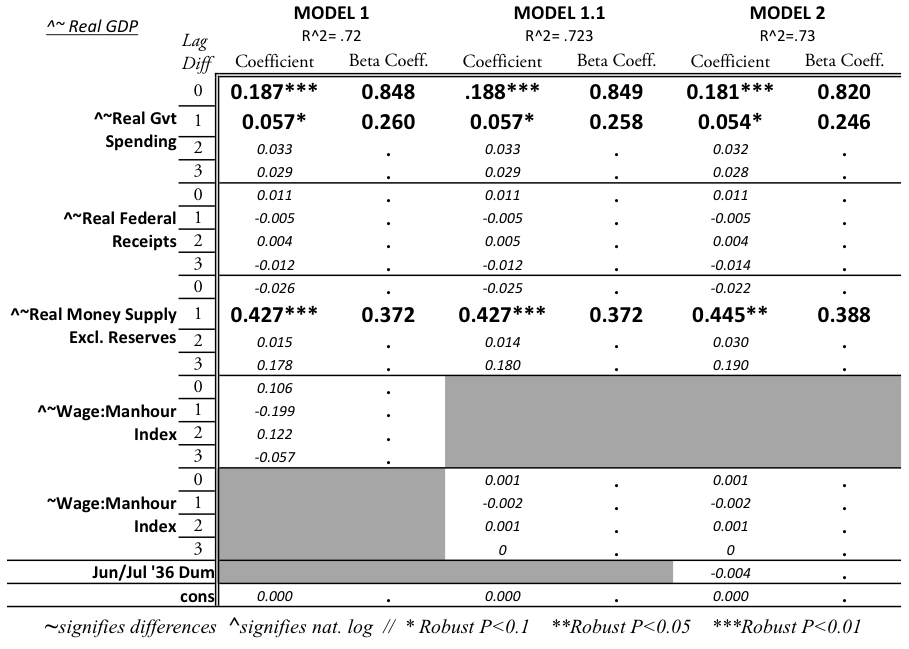
Table A-1

Table A-2
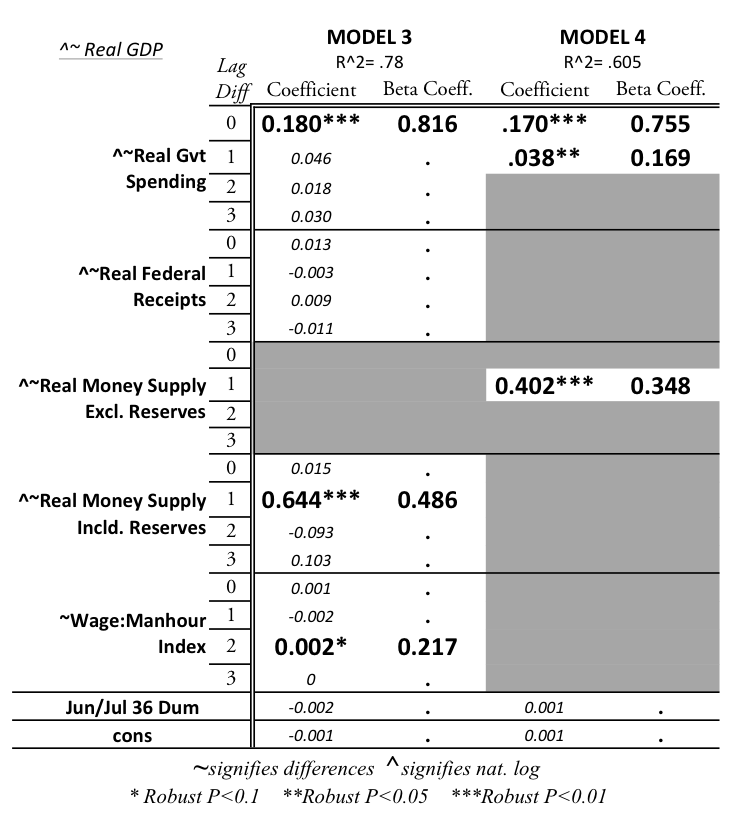
Table A-3
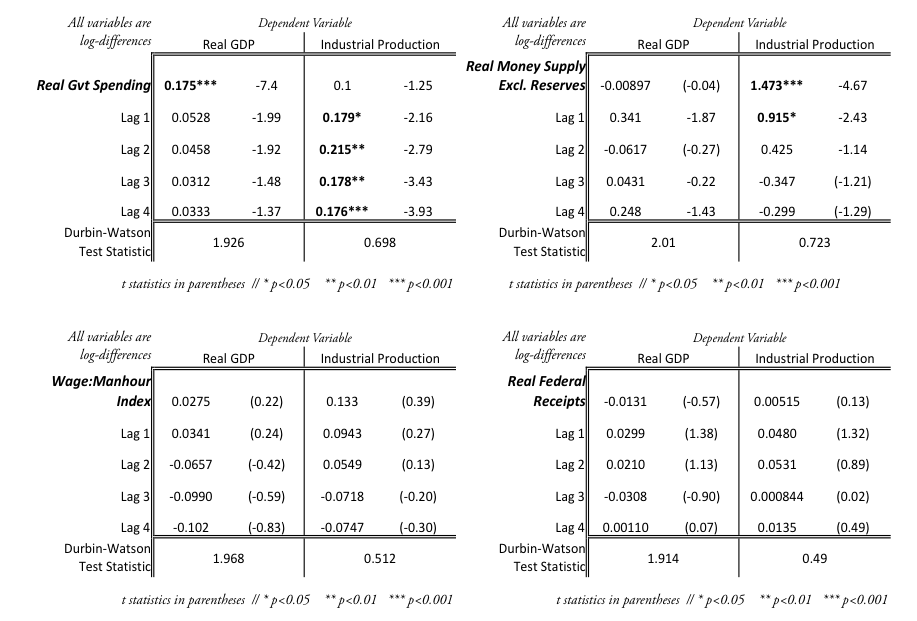
Table A-4. Simple regression of each independent variable on GDP or industrial production.
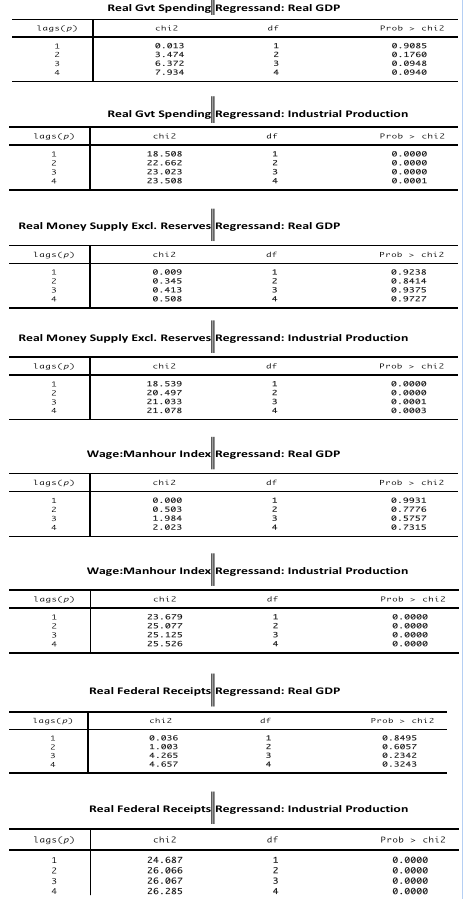
Table A-5. Breusch-Godfrey Test Results for Table A-4 regressions.
Figures
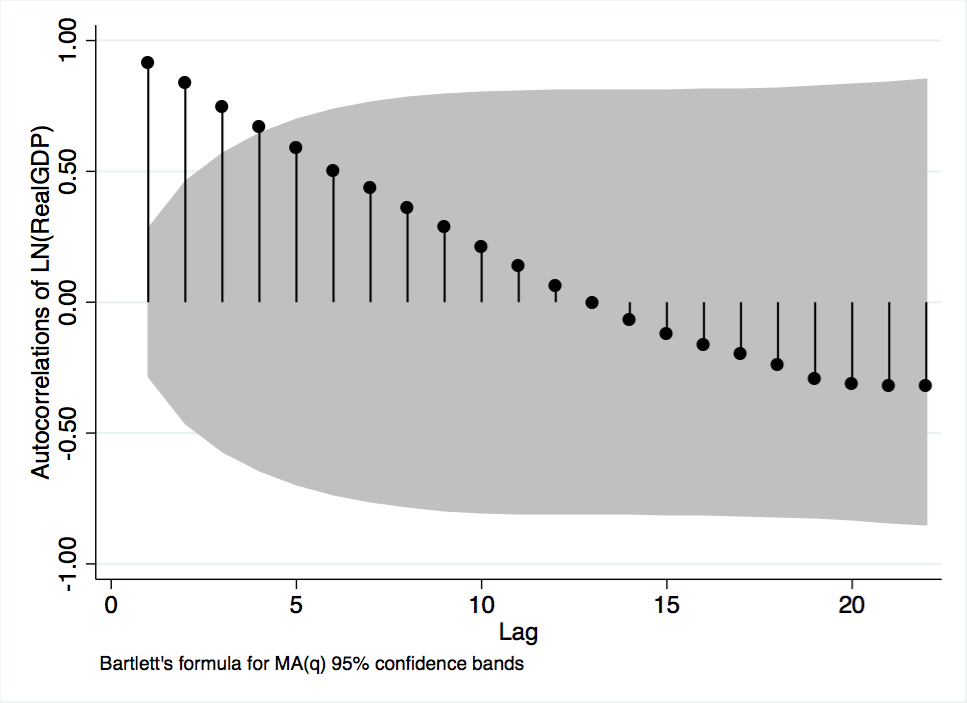
Figure A-1. Autocorrelation plot of GDP variable.
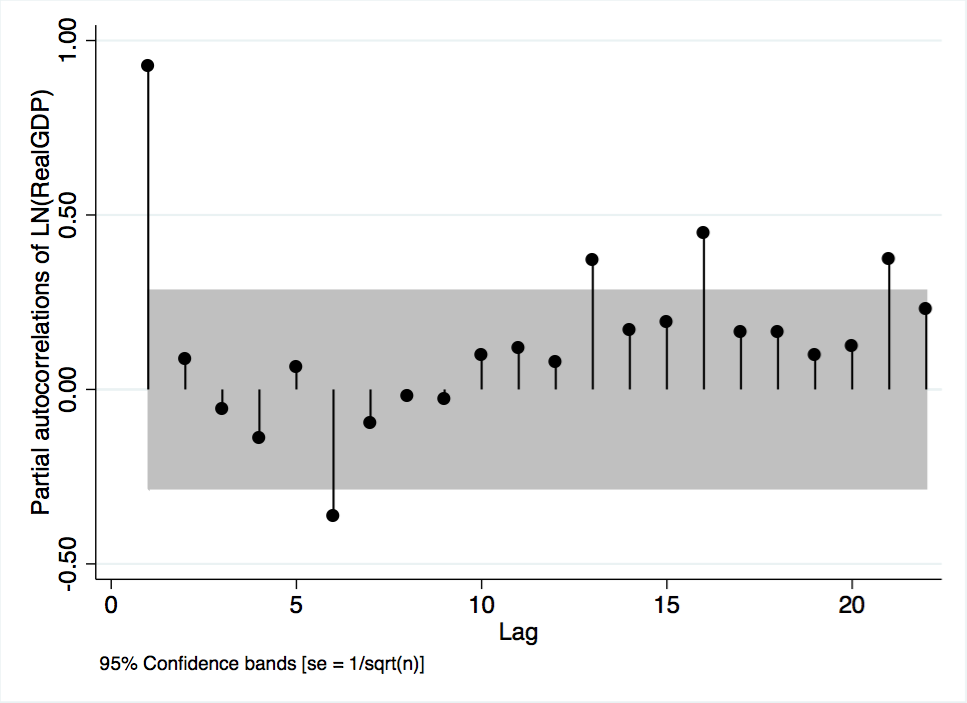
Figure A-2. Partial autocorrelation plot of GDP variable.
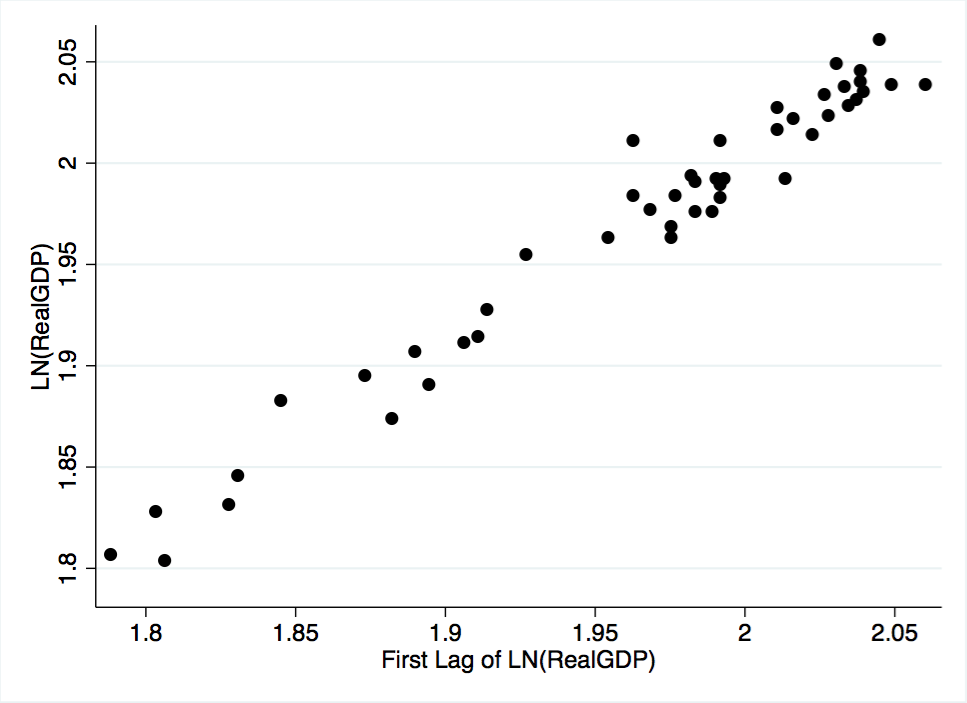
Figure A-3. Scatterplot of the GDP variable against its first lag.
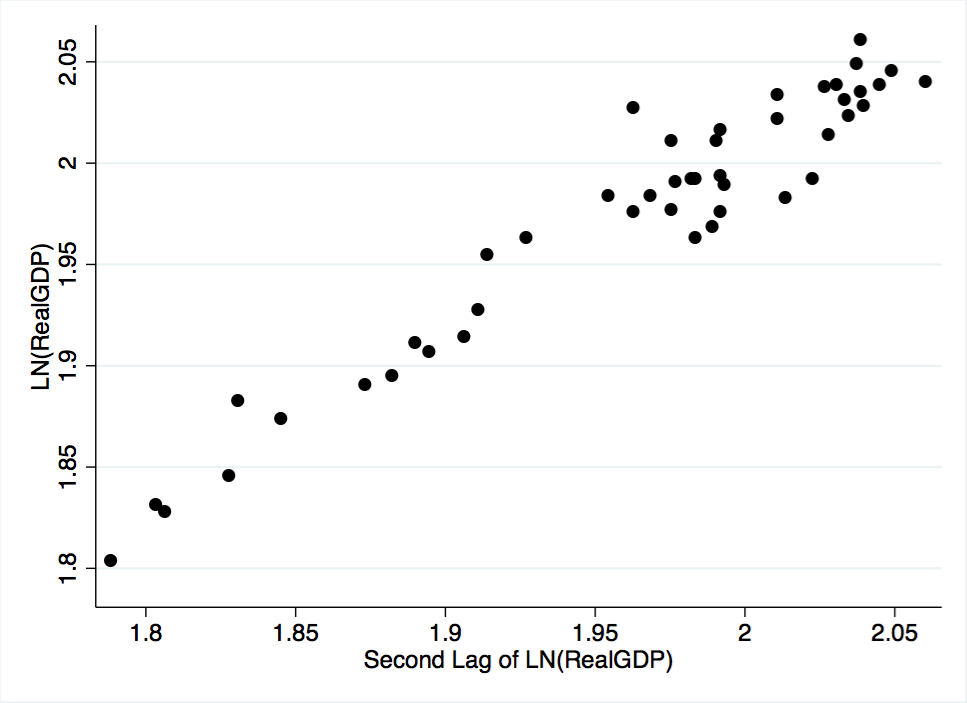
Figure A-4. Scatterplot of the GDP variable against its second lag.
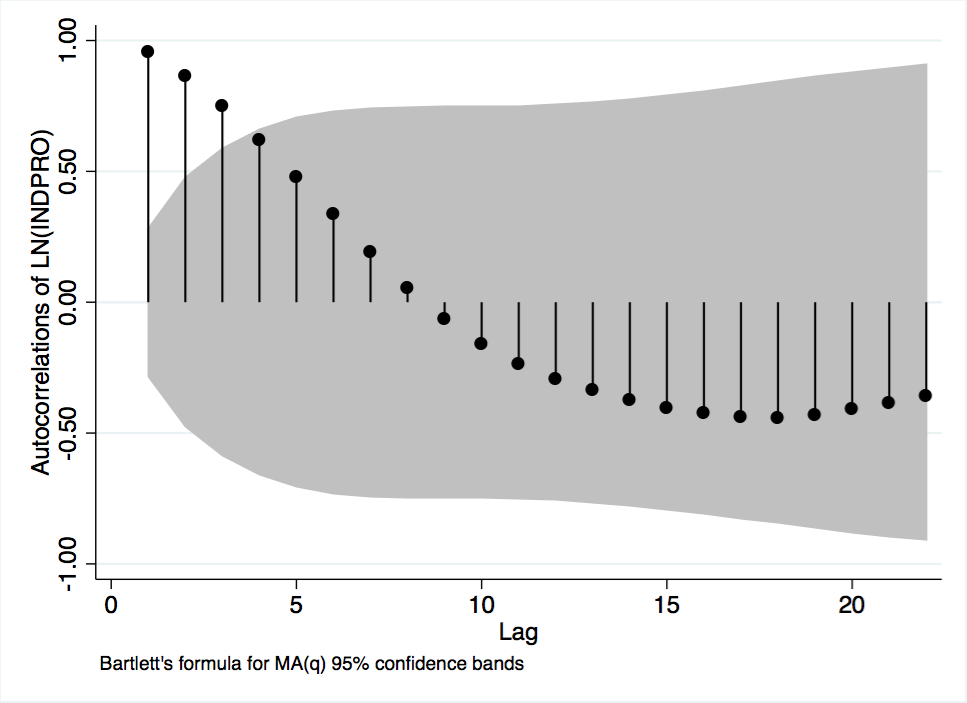
Figure A-5 Autocorrelations of Industrial Production
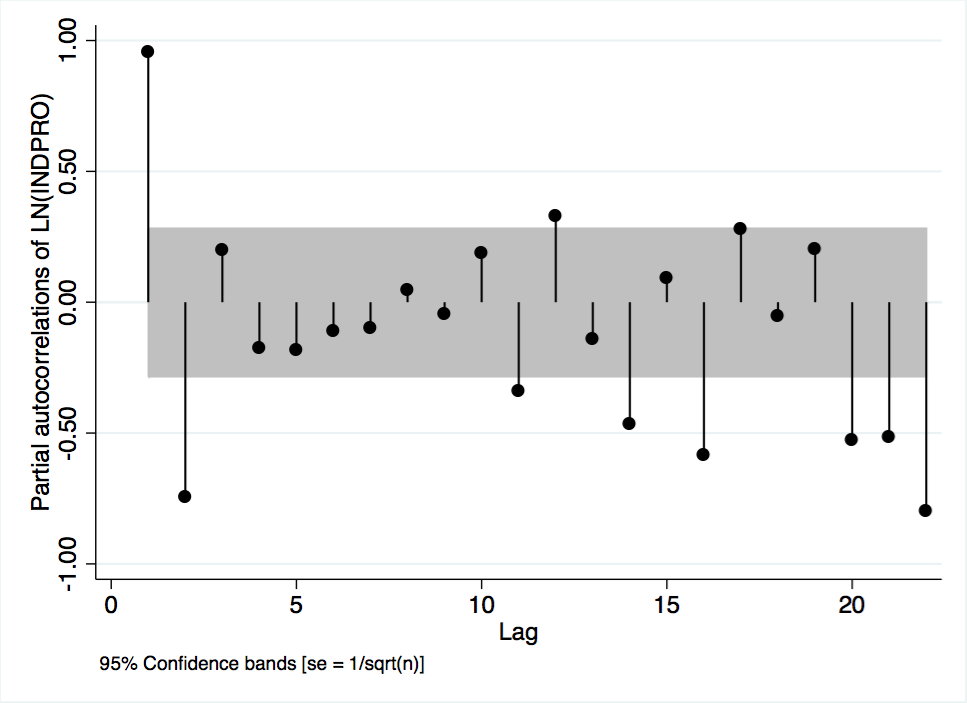
Figure A-6 Partial Autocorrelations of Industrial Production
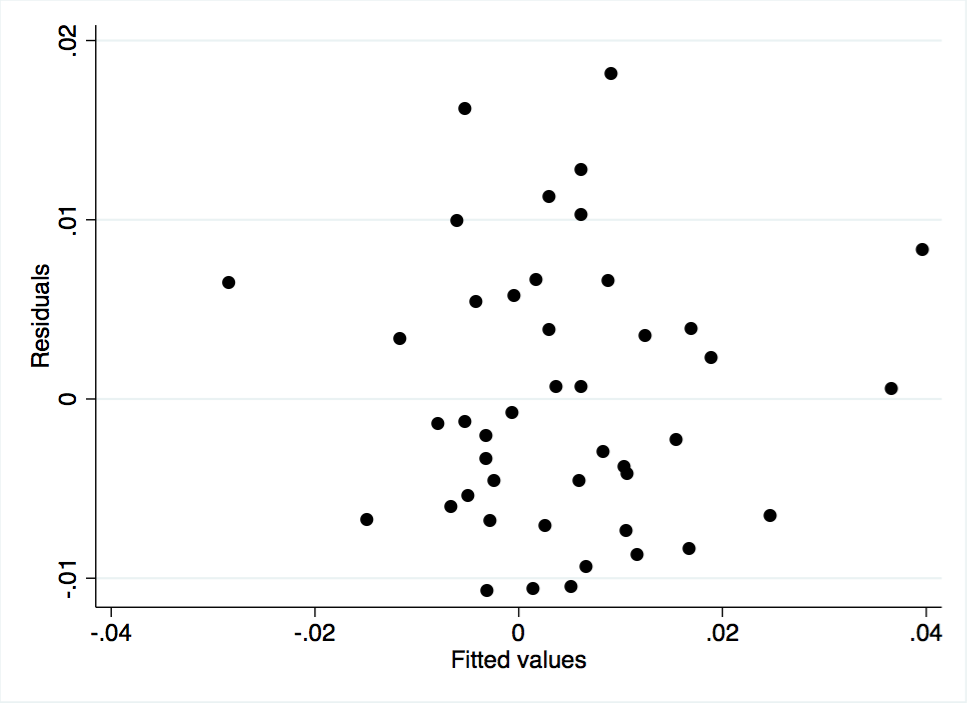
Figure A-7 Scatterplot of Model 1 Residuals Against Fitted Values
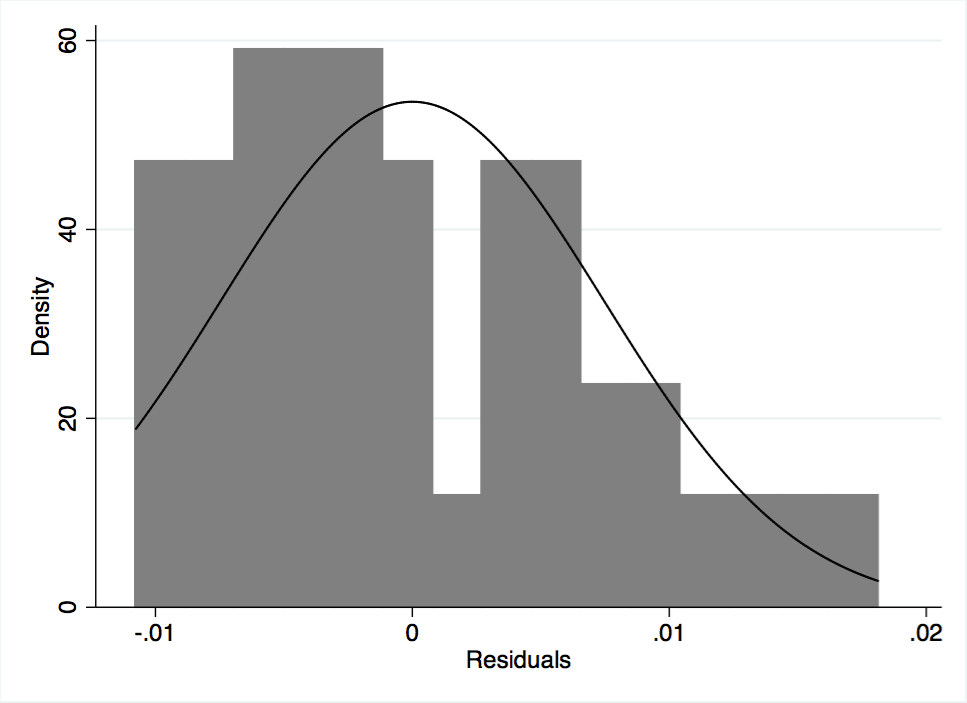
Figure A-8 Histogram of Model 1 Residuals
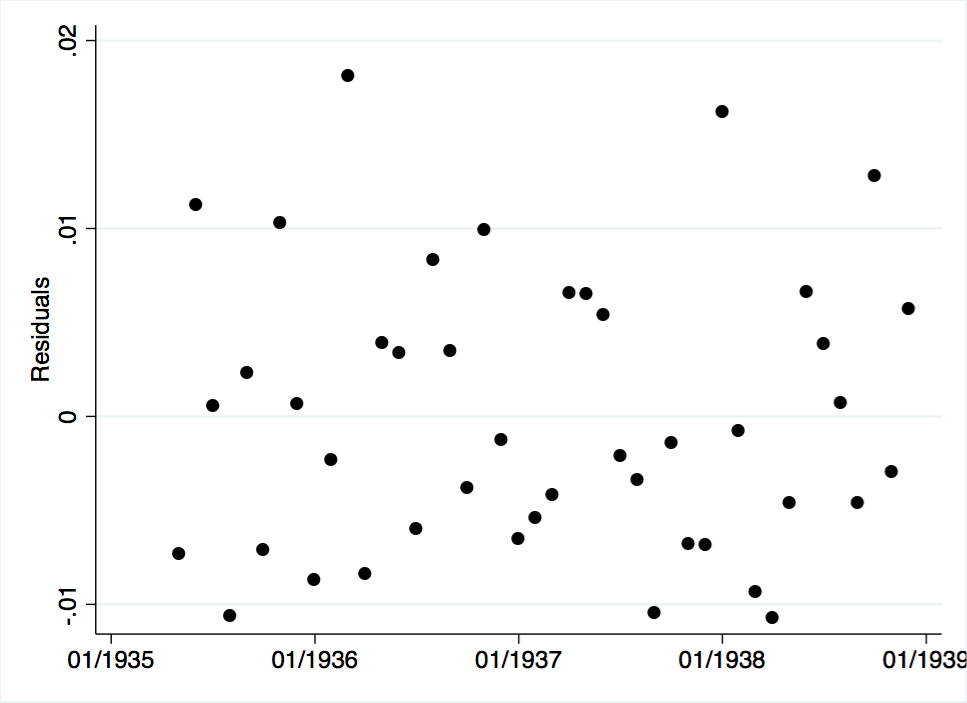
Figure A-9 Model 1 Residuals Plotted Over Time
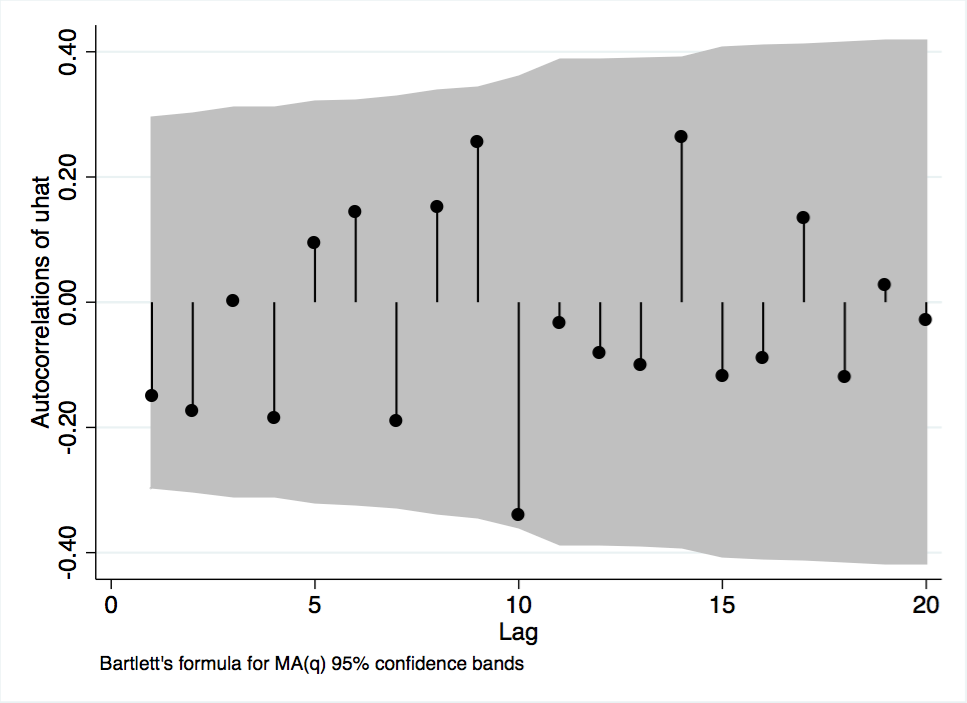
Figure A-10 Autocorrelations of Model 1 Residuals
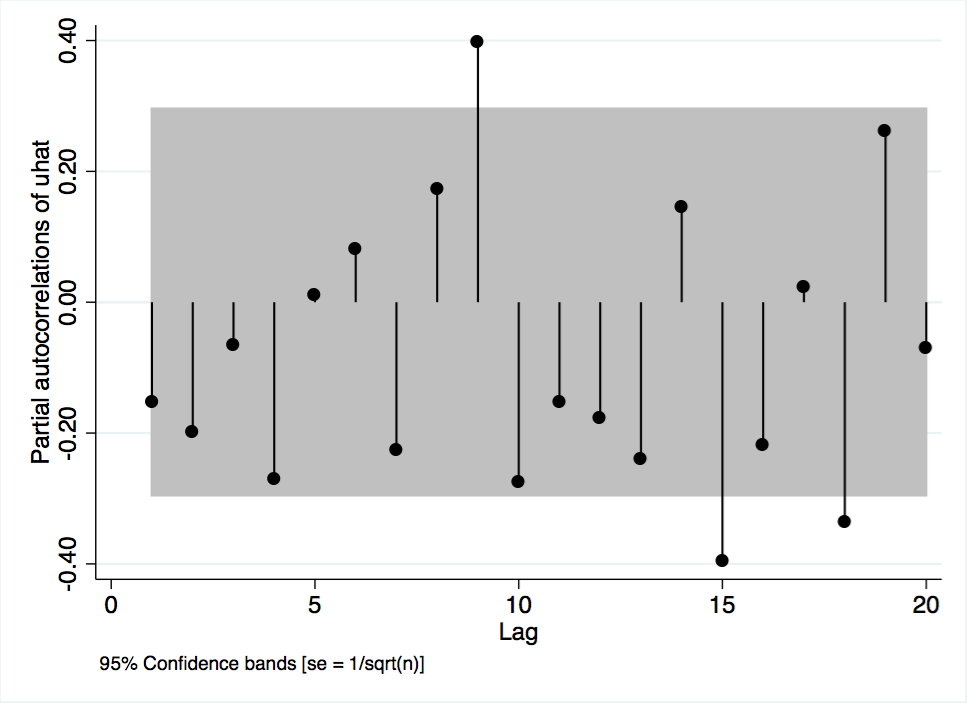
Figure A-11 Partial Autocorrelations of Model 1 Residuals
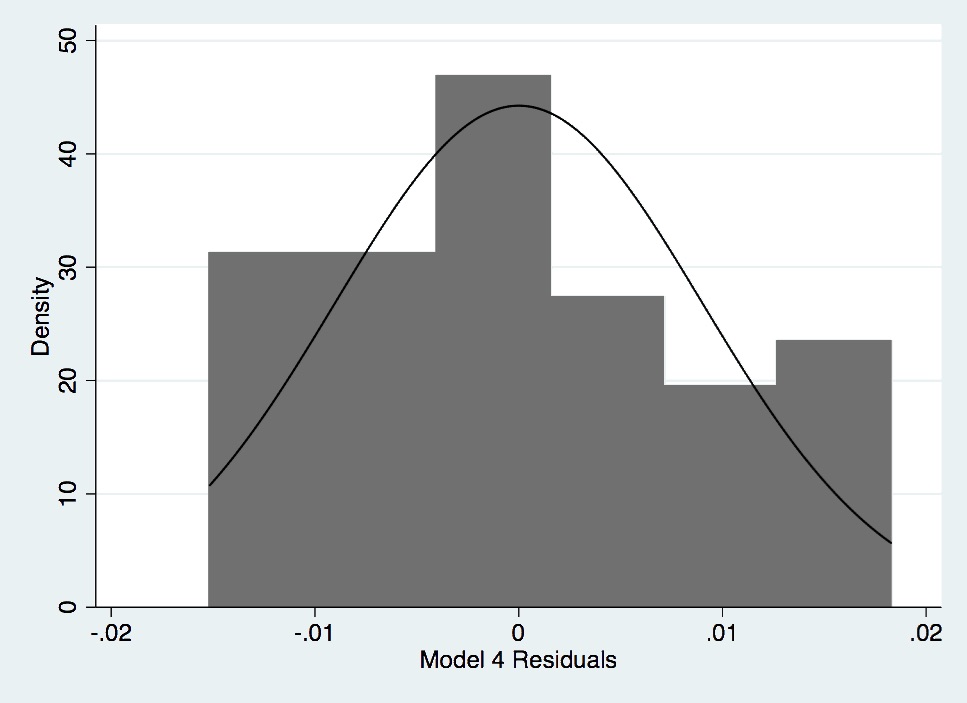
Figure A- 12. Histogram of Model 4 Residuals.
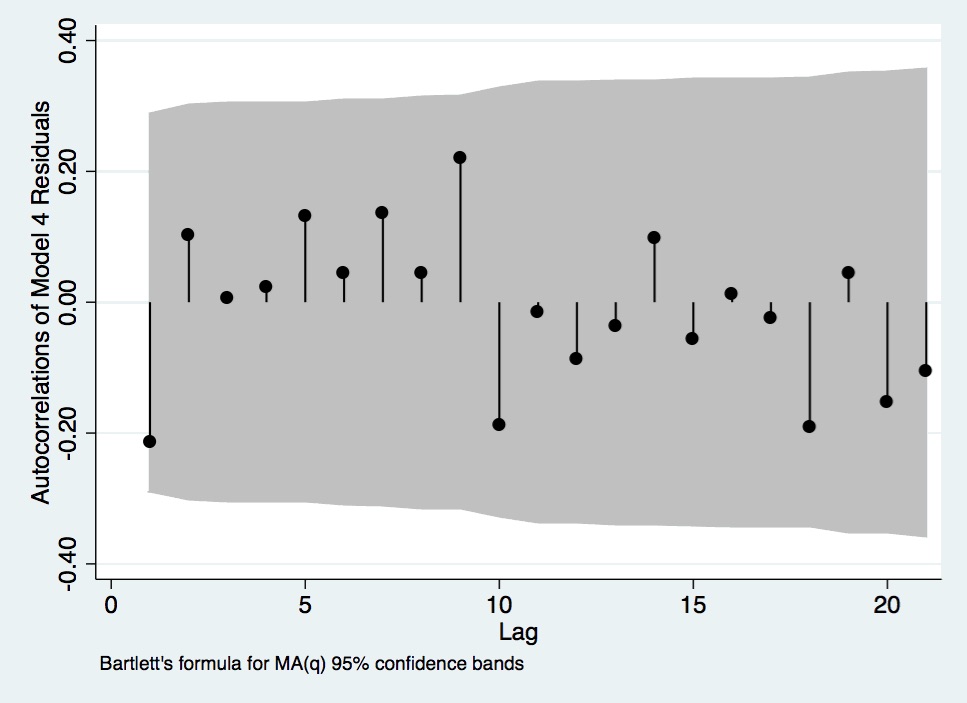
Figure A- 13. Autocorrelations of Model 4 Residuals.
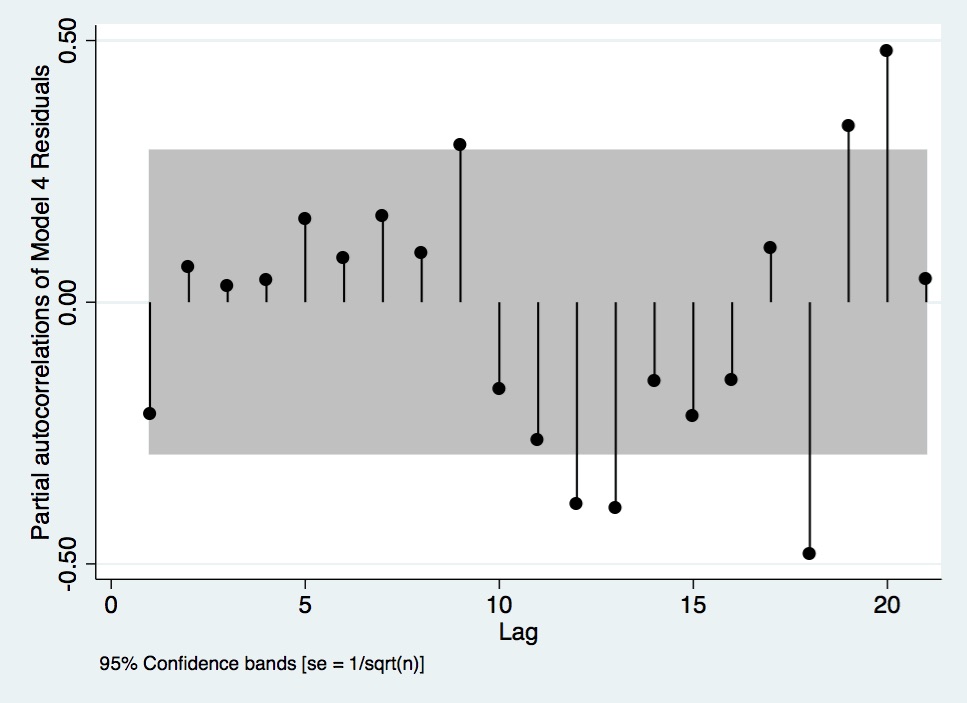
Figure A- 14. Partial Autocorrelations of Model 4 Residuals.
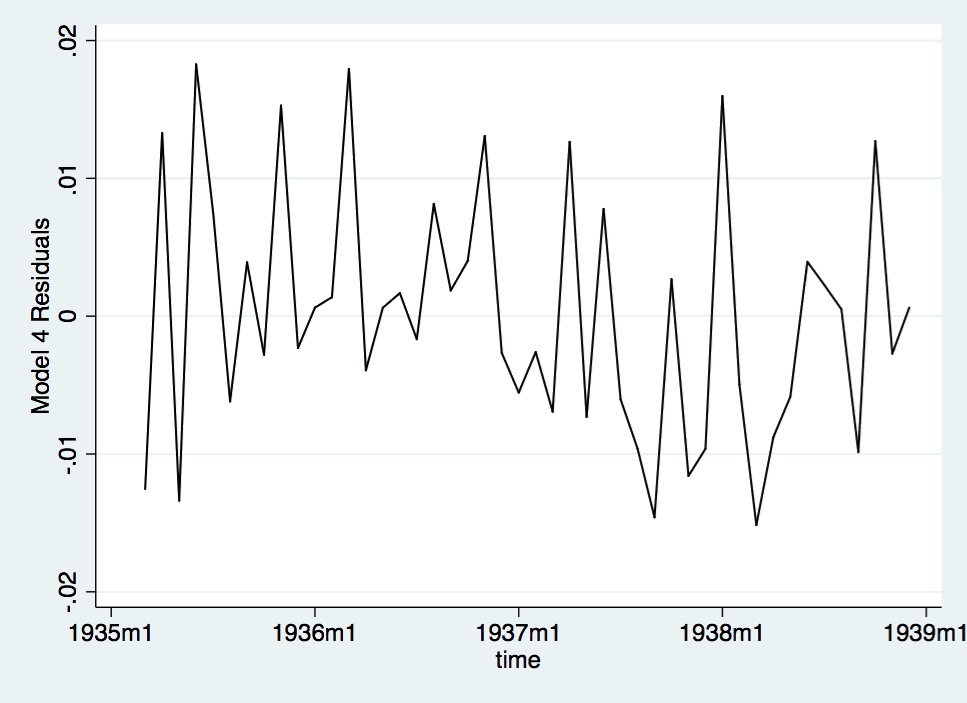
Figure A- 15. Lineplot of Model 4 Residuals.
Save Citation » (Works with EndNote, ProCite, & Reference Manager)
APA 6th
Rafti, J. (2015). "Roosevelt's Recession: A Historical and Econometric Examination of the Roots of the 1937 Recession." Inquiries Journal/Student Pulse, 7(06). Retrieved from http://www.inquiriesjournal.com/a?id=1053
MLA
Rafti, Jonian. "Roosevelt's Recession: A Historical and Econometric Examination of the Roots of the 1937 Recession." Inquiries Journal/Student Pulse 7.06 (2015). <http://www.inquiriesjournal.com/a?id=1053>
Chicago 16th
Rafti, Jonian. 2015. Roosevelt's Recession: A Historical and Econometric Examination of the Roots of the 1937 Recession. Inquiries Journal/Student Pulse 7 (06), http://www.inquiriesjournal.com/a?id=1053
Harvard
RAFTI, J. 2015. Roosevelt's Recession: A Historical and Econometric Examination of the Roots of the 1937 Recession. Inquiries Journal/Student Pulse [Online], 7. Available: http://www.inquiriesjournal.com/a?id=1053
Suggested Reading from Inquiries Journal
After years of economic downturn and recovery, the debate over stimulus packages and countercyclical policy continues globally. Proponents of such policies claim that the various stimulus packages and policy initiatives around the globe helped bring about quicker recovery, while opponents claim that in many cases these policies... MORE»
The Obama presidency will largely be defined by the administration’s ability to respond to the unique and historic challenge facing the country at the time of his inauguration: the Great Recession. This paper evaluates the president’s success throughout both of his terms in enacting an economic policy, which was largely... MORE»
The “Great Recession” of 2008 resulted in unprecedented levels of state deficit spending.[1] However, even though deficits are partly the result of economic forces beyond the control of state governments&mdash... MORE»
An exhibition entitled “The Quilts of Gee’s Bend” opened at the Whitney Museum of American Art in New York in November, 2002 (McGee), bringing worldwide attention to a secluded hamlet in a curve of the Alabama River. Unbeknownst to many of the admirers of these brightly patterned blankets was that the national spotlight had once before been shone on the town. That time... MORE»
Latest in Economics
2020, Vol. 12 No. 09
Recent work with the Economic Complexity Index (ECI) has shown that a country’s productive structure constrains its level of economic growth and income inequality. Building on previous research that identified an increasing gap between Latin... Read Article »
2018, Vol. 10 No. 10
The value proposition in the commercial setting is the functional relationship of quality and price. It is held to be a utility maximizing function of the relationship between buyer and seller. Its proponents assert that translation of the value... Read Article »
2018, Vol. 10 No. 03
Devastated by an economic collapse at the end of the 20th century, Japan’s economy entered a decade long period of stagnation. Now, Japan has found stable leadership, but attempts at new economic growth have fallen through. A combination of... Read Article »
2014, Vol. 6 No. 10
In July 2012, Spain's unemployment rate was above 20%, its stock market was at its lowest point in a decade, and the government was borrowing at a rate of 7.6%. With domestic demand depleted and no sign of recovery in sight, President Mariano Rajoy... Read Article »
2017, Vol. 9 No. 10
During the periods of the Agrarian Revolt and the 1920s, farmers were unhappy with the economic conditions in which they found themselves. Both periods witnessed the ascent of political movements that endeavored to aid farmers in their economic... Read Article »
2017, Vol. 7 No. 2
In 2009, Brazil was in the path to become a superpower. Immune to the economic crises of 2008, the country's economy benefitted from the commodity boom, achieving a growth rate of 7.5 per cent in 2010, when Rousseff was elected. A few years later... Read Article »
2012, Vol. 2 No. 1
The research completed aimed to show that the idea of fair trade, using the example of goals for the chocolate industry of the Ivory Coast, can be described as an example of the economic ideal which Karl Marx imagined. By comparing specific topics... Read Article »
|






































